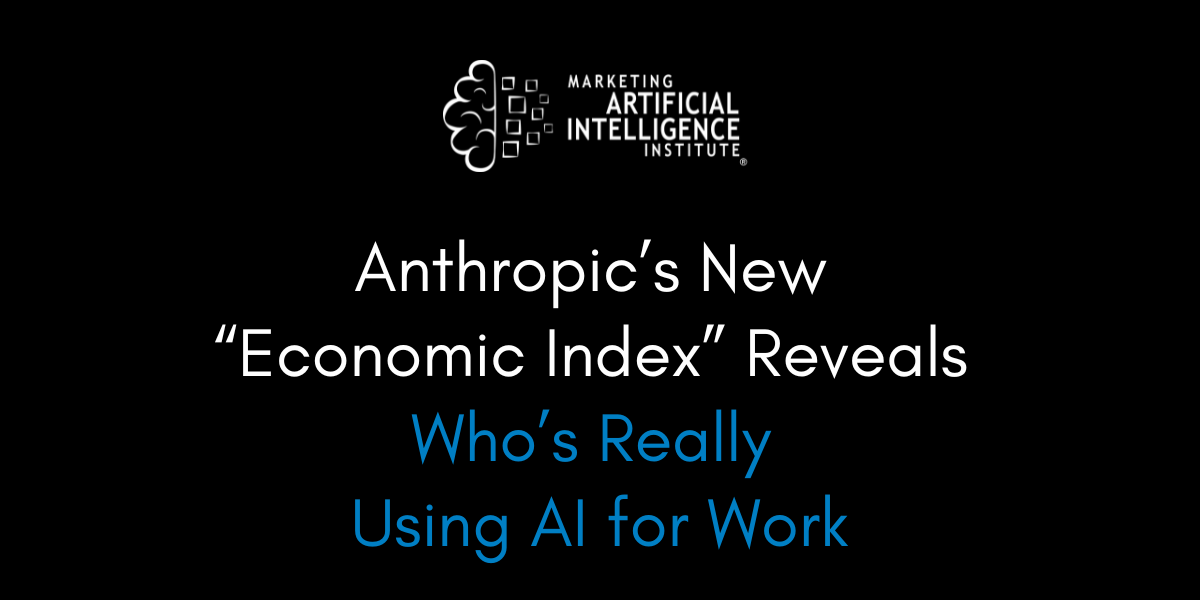Anthropic just dropped a thought-provoking new study that reveals a surprising snapshot of how AI is actually being used in the wild—and which jobs and tasks might feel its impact the most.
They’re calling it the Anthropic Economic Index, and it’s based on millions of anonymized interactions with Claude, Anthropic’s AI model. The data offers what Anthropic claims is a “first of its kind” real-world view of how AI is transforming occupational tasks across the economy.
But here’s the kicker:
It also suggests that, despite all the hype about AI automating entire professions out of existence, that’s not what’s really happening—at least not yet.
So, what does this new index actually say? And how seriously should we take it?
I got some insights from Marketing AI Institute founder and CEO Paul Roetzer on Episode 135 of The Artificial Intelligence Show.
The Numbers Behind the Index
According to Anthropic’s study, usage of Claude is heaviest for computer-related and technical writing tasks. These two fields alone account for almost half of all interactions analyzed—unsurprising, given that Claude has a reputation for excelling at coding and generating text.
But Anthropic also notes AI’s reach is broader than just techies. They estimate that about 36% of occupations may already be using AI for at least a quarter of the tasks tied to those roles. The data hints that AI—at least from this single perspective—touches a range of job functions across the wage spectrum.
Augmentation vs. Automation
Perhaps the most interesting finding is that AI is “augmenting” people’s work more than it is automating it. According to Anthropic, 57% of AI usage is about enhancing or assisting human capabilities, while 43% falls into actual automation territory.
That means, for a lot of people, AI seems to be boosting productivity—writing code faster, ideating project plans, polishing copy—rather than outright replacing workers.
Where AI Usage Peaks (And Where It Doesn’t)
Anthropic’s data also shows a surprising pattern in terms of wages. AI usage is highest in mid to high wage occupations—like computer programming and data science—and tails off at the very top and bottom of the wage scale.
One reason for this might be that specialized AI usage in certain high-wage roles hasn’t yet caught on—or maybe it’s that some of the highest earners have niche tasks Claude isn’t good at. Meanwhile, lower wage occupations may face other barriers to adoption or have tasks that Claude (and AI in general) isn’t yet addressing effectively.
Should We Trust This Data?
It’s an honest question. In fact, Roetzer raised a key point:
“I don't think that they have very broad awareness or usage in the general public,” he says of Claude. So the data may be skewed to a smaller group of users than, say, what you might learn analyzing conversations from ChatGPT.
Anthropic itself acknowledges the study’s other limitations, too. The analysis can’t tell us for sure whether interactions with Claude actually happened at work, or how people implemented its outputs in real-world workflows. Plus, Claude doesn’t generate images, can’t browse the internet, and lacks multimodal capabilities—so it misses plenty of AI use cases that happen outside writing and coding.
A First Step—But Far From the Whole Story
Despite the caveats, the Anthropic Economic Index offers a valuable glimpse into how some real users (at least on Claude) are harnessing AI. It confirms that programming and writing tasks are seeing major AI adoption—and that most professionals appear to be using AI as a collaborator, not a complete replacement.
However, as Roetzer points out, we should be cautious before taking this data as gospel. Tools like OpenAI’s ChatGPT (with far more public awareness) likely paint a broader picture.
“I hope other platforms with more awareness and usage follow suit and start publishing research like this, because I think it would be helpful,” he says.
Until we do, Anthropic’s findings give us a peek into AI’s impact on certain occupations—and may foreshadow what happens as models grow more advanced. But one thing’s for sure:
This is just the beginning.
Mike Kaput
As Chief Content Officer, Mike Kaput uses content marketing, marketing strategy, and marketing technology to grow and scale traffic, leads, and revenue for Marketing AI Institute. Mike is the co-author of Marketing Artificial Intelligence: AI, Marketing and the Future of Business (Matt Holt Books, 2022). See Mike's full bio.

